Heterogeneity of Indigenous Australians
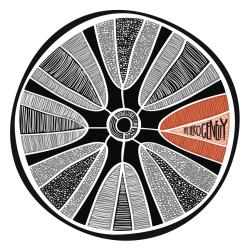
Artwork by Lucy Simpson, Gaawaa Miyay Designs, gaawaamiyay.co.
Cultural diversity
Aboriginal and Torres Strait Islander peoples’ cultures are complex and diverse. There were about 600 different language groups populating the continent when the British arrived, many with distinctive cultures and beliefs.
The diversity of Indigenous Australians’ cultures stems from the diversity of the Australian landmass. First peoples’ ‘Territories’ ranged from lush woodland areas to harsh desert surroundings. Different nation groups developed different skills, and built an adapted and sophisticated body of knowledge based on their environment that sustained the land’s resources over many thousands of years.
"We cultivated our land, but in a way different from the white man. We endeavoured to live with the land; they seemed to live off it. I was taught to preserve, never to destroy." Tom Dystra
The meaning of country
All areas of Australia have traditional owners, including where there are now large cities. As the land has changed over time, so Indigenous cultures have adapted to those changes. Even though Aboriginal people may not live in a traditional way on this land, they are still bound to it. In Aboriginal culture, the meaning of country is more than just ownership or connection to land.
"When we talk about traditional ‘country’… we mean something beyond the dictionary definition of the word. For Aboriginal Australians…we might mean homeland, or tribal or clan area and we might mean more than just a place on the map. For us, country is a word for all the values, places, resources, stories and cultural obligations associated with that area and its features. It describes the entirety of our ancestral domains." Mick Dodson
If you participated in an activity that involved Aboriginal people you might have experienced a Welcome to Country or Acknowledgement of Country. Both are protocols that precede a function. They recognise the unique position of Aboriginal people in Australian culture and history and show respect for Aboriginal people.
If you are planning to include a ‘Welcome to Country’ or do an ‘Acknowledgement of Country’ make sure to consult with Aboriginal people of the community where the event takes place. This way you ensure that the ceremony pays the appropriate level of recognition and involves the right people. If you are holding an event at UTS, consult the Jumbunna website for the university’s Background and Protocols for Acknowledgement of Traditional Owners and information on Displaying the Australian national, Aboriginal and Torres Strait Islander flags at UTS events.
Terms for the first peoples of Australia
Although the terms ‘Indigenous’, ‘Aboriginal’ and ‘Torres Strait Islander’ are commonly used now, it is important to note that these names are colonial labels imposed on a range of people with diverse cultures and languages. Before, during and after invasion the First Nations people of Australia identified themselves by their country such as Darug, Gandangarra, Tharawal, Eora, Kamilaroi, Wiradjuri and Bund jalung.
Aboriginality is not defined by a person’s skin tone or where they live. The colour of an Aboriginal person’s skin may become lighter through different generations; it is also common for many Aboriginal people within the same family to have different complexions to each other. A person’s Aboriginality should never be judged by their skin tone. It is inappropriate to comment on the colour of a person’s skin in reference to their Aboriginality.
Language
Language is vitally important in understanding Indigenous heritage as much of the history is an oral history. At the time of colonisation, hundreds of languages and dialects existed, and language meaning, as well as geographic location, is used today to identify different groups. Explore the Gambay - First Languages Map.
Past assimilation policies prohibited Aboriginal people from using their language which contributed to the breakdown in the teaching of language between generations. Many languages have been lost as a result. However, in some communities language is still strong and is being revived and taught at schools and published in books.
Despite there being no single Indigenous culture – Indigenous people across Australia have a variety of cultures that combine contemporary and traditional thoughts and practices – there are some common protocols one must observe. Consult with the NSW Government’s Working with Aboriginal people and communities: a practice resource[1]. Always consult with an Indigenous person if unsure as to how to negotiate cultural differences.
Government legislation
The Commonwealth and various State Governments have acknowledged that past legislation and practices enforced on Indigenous people (e.g. assimilation policies) have contributed to Indigenous people being one of the most disadvantaged socio-economic groups in Australia. The effects of these policies have left lasting inter-generational impacts which need to be addressed.
A turning point in Indigenous affairs was the 1967 referendum, which endorsed an amendment to the Australian constitution to remove two discriminatory provisions. Federal legislation has since been enacted covering land rights, discriminatory practices, financial assistance and preservation of cultural heritage.
Impact on health
Nonetheless, various government legislation and policies have contributed, and continue to contribute to:
- dispossession of land
- family fragmentation
- mental health issues
- social and emotional wellbeing issues
- grief and loss issues
- poverty
- racism
- unemployment
- poor health outcomes
- poor housing standards
- below standard literacy and numeracy rates
- alcohol and substance abuse/misuse
- over-representation in the juvenile and criminal justice system.
When these issues occur they impact upon health, social and emotional wellbeing.
Chapter References
[1] NSW Department of Community Services (2009), Working with Aboriginal people and communities: a practice resource.
Artwork
The artwork produced by Aboriginal people is as diverse as they are. The progression of Indigenous art styles has been strongly influenced by Australia’s history of colonisation, the influence of governments and churches and exposure to Western art economics (Australian Government 2007). From 40,000-year-old engravings in rock to contemporary photographic and multi-media projects, ‘Aboriginal art’ encompasses the gamut of genres, styles and materials.
UTS ART Education and Outreach Co-ordinator Alice McAuliffe and academic Jennifer Newman have produced a series of videos that explore the cultural and social contexts of Indigenous artwork from the UTS Art collection.
‘Flag’ by Archie Moore
Archie Moore, a Sydney-based artist, challenges us to acknowledge the diversity that exists amongst Indigenous Australians. The series Flag is a set of acrylic works that take the basic form and colours of the Aboriginal flag. Instead of the yellow ‘sun’ in the centre, however, he has placed symbols and motifs from many places including the West, the East, politics, sub-culture or counter culture: all suggesting an Indigenous multiculturalism that non-Indigenous Australians often assume does not exist.
Watch the video Heterogenity of Indigenous Australians - Archie Moore ‘Flag’, for more information.
Additional artwork
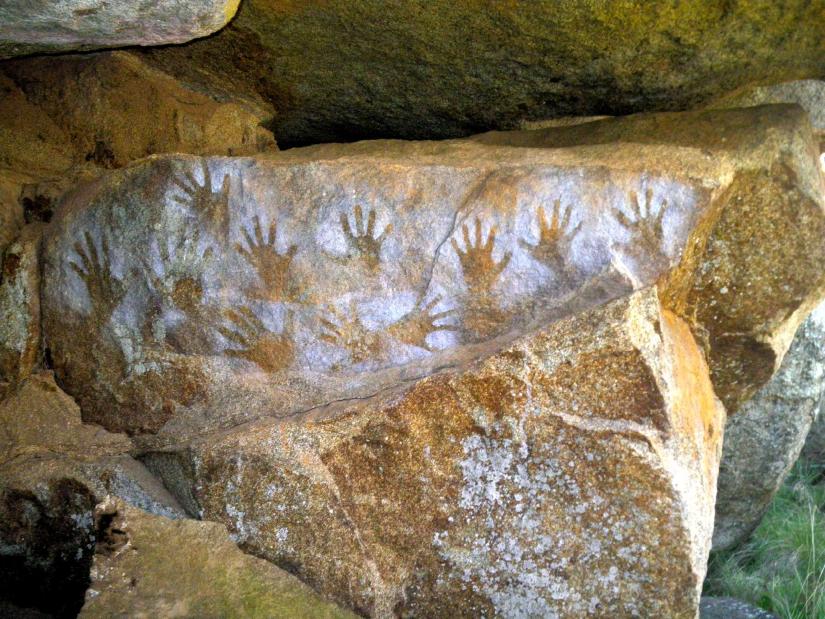
Aboriginal Rock Art reproduced with the kind permission of Don Hitchcock, donsmaps.com.
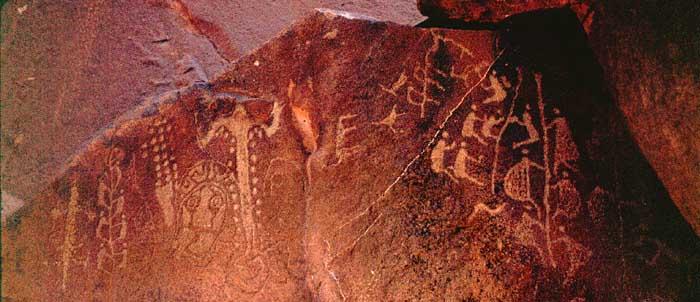
Murujuga petroglyphs. “Copyright by Robert G. Bednarik, with permission by Traditional Custodians”.
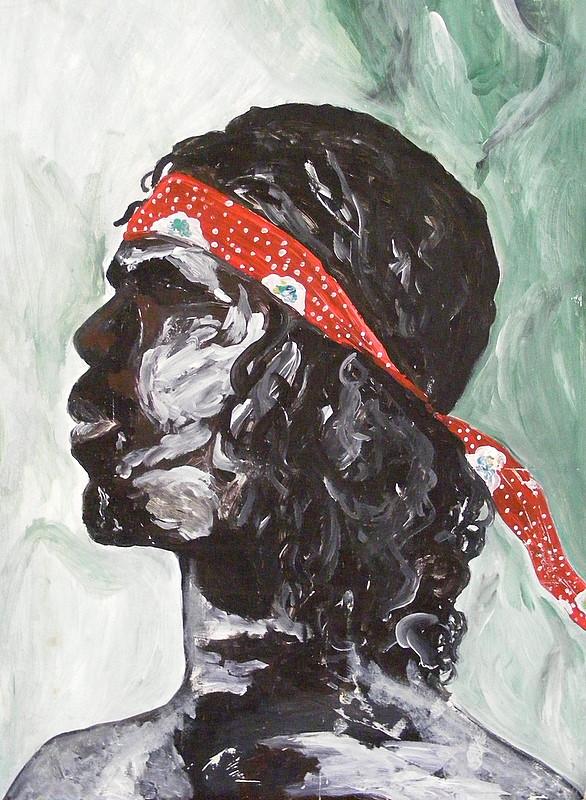
Indigenous Man by Jacqui Stewart. Image provided by the artist. jacquistewart.com.au

Life on a Mission, by Richard Bell. Reproduced with kind permission of the artist.
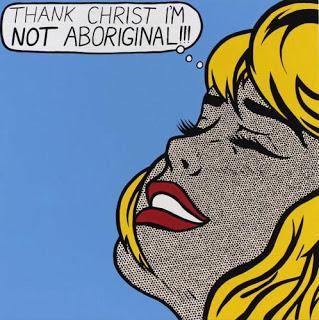
The Peckin Order, by Richard Bell. Reproduced with kind permission of the Artist.

Aussie Aussie Aussie 2002, by Richard Bell. Reproduced with kind permission of the Artist.
